
Having a well-constructed 4-betting range will make you a nightmare to play against at the poker table. A 4-bet is when a player makes the fourth bet/raise on any street. Since post-flop 4-betting does not happen often and this action most commonly occurs in pre-flop situations, this article will look solely at the pre-flop side of things. To clarify, a pre-flop 4-bet refers to when a player raises after another player has raised (3-betted) the raise-first-in. We’ll give the strategic breakdown of all the key concepts you will need to effectively incorporate 4-betting into your own game: why it is done, the factors that change a 4-betting range, which hands to do it with and why. We’ll also discuss the best 4-bet sizing to use, using a mixed strategy, and reveal how you can make exploitative adjustments against certain opponents.
Why Do We 4-Bet?
Before we get into the specifics on which hands you should be 4-betting, it is crucial to understand why it is done in the first place. This will help you to understand the strategy better as a whole.
Get Value
The most obvious reason why we 4-bet is to get value from worse holdings when we have a premium hand. By building the size of the pot with these strong hands pre-flop, we make it easier to extract more value from our opponent(s) on later streets.
As a Bluff for Balance
Since it is clear that we want to have our strongest value hands in this 4-betting range, we need to also include some bluffs to make sure that our range is balanced. This is a fundamental concept in poker and trying to be balanced with our ranges in all spots will make us a much tougher opponent to play against. Imagine that we are against a player that only makes 4-bets with strong value hands. For us, adjusting to counter this type of strategy would be very simple. We can just fold all of the weaker parts of our range, call with our stronger hands and raise with our very best holdings. Compare this opponent against a player that 4-bets with a balanced range consisting of both strong value hands and bluffs. Against this balanced range, it is much harder for us to make any adjustments to exploit our opponent.
To Steal the Pot
Another reason that we should 4-bet is to take down the dead money that is in the pot. Given that there is usually going to be at least 13 big blinds in the pot when you are presented with the opportunity to 4-bet (the blinds (1.5bb) + open-raise (2.5-3.5bb) + 3-bet (10bb)), there are a lot of chips out there for taking. If there have also been additional calls to the open-raise or 3-bet, the pot can grow to a sizeable amount which makes 4-betting to take it down an attractive opportunity. When we talk about stealing the pot, it generally refers to when we are 4-betting as a bluff – getting to win the pot without taking the flop and realising 100% of our equity is definitely a win.
To Isolate
Because our chance of winning the hand post-flop decreases with every additional player in the pot, it is in our interest to try and reduce the number of players by 4-betting when we are presented with a spot where it is suitable to do so. Just to prove this point, look at the equity that AKs/AKo has against three other opponents playing any two cards:
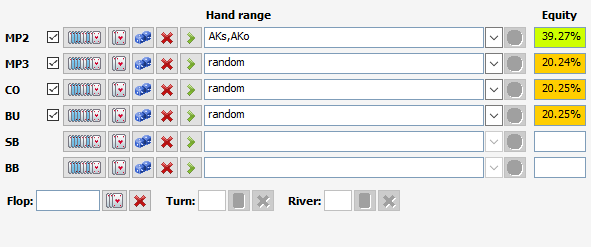
As the equities show, AK will win this hand at showdown less than 40% of the time in a 4-way pot. However, against only one other opponent, AK becomes a significant favourite and wins at showdown over 65% of the time:

For this reason, 4-betting after another player has 3-bet makes it less likely that other players will come along as their odds are now worse, which in turn increases the likelihood of you winning the hand. Isolating in this manner can also be done when there are weaker players at the table that have 3-betted.
Factors Influencing Our 4-Betting Range
Before we actually break down 4-betting ranges from a variety of positions, we need to understand the factors that shape these ranges. This will help you to be fluid with your own ranges and learn how to better your 4-betting strategy from each position.
Position of the open-raiser
We need to consider the range of the open-raiser when developing our 4-betting strategy. This is because a 3-betting range changes based upon the strength of the open-raising range, and our 4-betting range changes upon the strength of the 3-betting range. A player’s opening range will be tightest in the earliest position (as there are more players left to act behind with potentially strong holdings), and gradually widen as their position moves around to the Button. Below is a table showing standard opening ranges from each position to prove this point:
| Position | Range | Percentage of all possible hands |
| UTG | 55+,ATs+,A4s-A5s,KJs+,QJs,T9s,98s,87s,76s,ATo+,KJo+ | 13.88% |
| HJ | 44+,ATs+,A2s-A5s,KTs+,QTs+,T9s,98s,87s,76s,65s,ATo+,KJo+,QJo | 16.74% |
| CO | 22+,A2s+,K9s+,Q9s+,J9s+,T9s,98s,87s,76s,65s,A9o+,KTo+,QTo+,JTo | 23.68% |
| BTN | 22+,A2s+,K2s+,Q7s+,J7s+,T6s+,96s+,85s+,74s+,64s+,53s+,A2o+,K8o+,Q9o+,J8o+,T9o,98o,87o | 44.19% |
| SB | 22+,A2s+,K2s+,Q7s+,J7s+,T7s+,97s+,86s+,75s+,64s+,54s,A7o+,K9o+,Q9o+,J9o+,T9o,98o | 35.44% |
As the table shows, our opening range is tightest from the Button – not the Small Blind. This is because of the positional advantage that we get to enjoy when opening from the Button compared with the Small Blind. Against a competent player in the Big Blind, we can easily get punished if we open too wide of a range by aggressive 3-betting. The tighter the opening range, the tighter the 3-betting range should be from the player that is raising versus the open.
Position of the 3-Bettor
We should also be considerate of how the position of the 3-bettor will also change their range to some extent, and how this in turn affects our 4-betting range. For example, a player in the SB facing a raise-first-in should be raising more frequently than calling. This is because of the positional disadvantage that a player is at when playing out of this position, and also because of the increased odds you give the player in the BB to defend if you call rather than 3-bet. Compare the difference between a CO 3-betting range versus a UTG open with a SB 3-betting range versus a UTG open:
CO 3-Bet vs UTG Open
Red = 3-bet
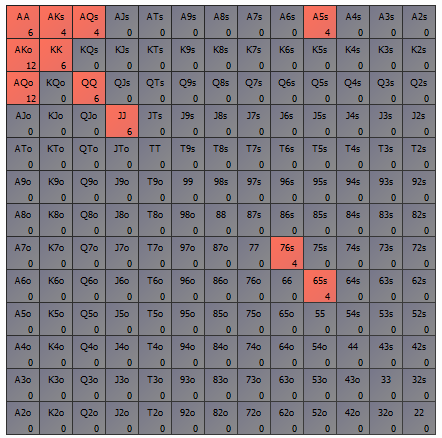
SB 3-Bet vs UTG Open
Red = 3-bet
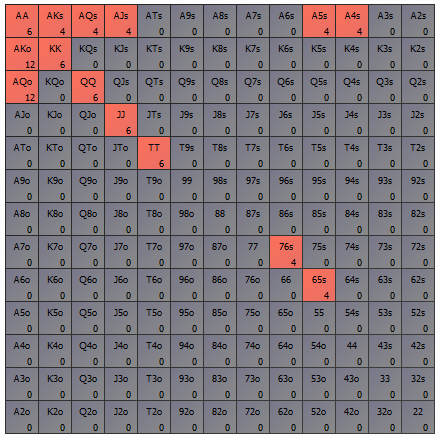
Despite both facing a tight UTG opening range, the CO 3-betting range is marginally tighter than the SB 3-betting range. The SB has an additional 14 combos in its 3-betting range in this spot (TT, A4s, AJs), and this is because you are disincentivised to flat versus an open from this position.
Our Own Position
We also need to consider how our position at the table influences our own range and how it is perceived by others. For example, if we open from UTG and face a raise from a player in the CO, we can expect to be facing a tight 3-betting range given the strength of our own opening range. This results in us having a narrower 4-betting range from this position. Compare this against a BTN opening range, which will consist of around 44% of hands. Given that a player in this position is opening a lot wider, the players in the SB and BB should be 3-betting a much wider range against a BTN open.
The Ranges
Now we’ve covered the general factors that shape our 4-betting range, let’s take a look at what some of these actual ranges look like. Because there are so many different possible 4-betting scenarios, we’ll focus on three varied examples here and the ranges for them. To show how these ranges change based upon 3-betting and RFI ranges, we’ll include the 3-betting ranges in play for each example as well. Remember that these ranges aren’t definitive – you should always be flexible with your range construction and adjust it based upon all of the different variables at play.
Example 1: UTG Open-Raise Versus BB 3-Bet
BB 3-Bet Range Versus UTG Open-Raise
Red = 3-bet (4.22% of all possible hands)

UTG 4-Bet Range Versus BB 3-Bet
Green = 4-bet (1.51% of all possible hands)

In this first example, you’ll notice that the UTG 4-betting range is extremely narrow, consisting of only 20 combos. This is because the BB 3-betting range itself is very tight given the expected tightness of a UTG open-raising range. For this reason, it doesn’t make sense to include AK in this 4-betting range. Because the UTG player will have position in this spot, flatting with hands like AK becomes more profitable than raising, especially given that AQs is included in this BB 3-betting range.
Example 2: BTN Versus CO 3-Bet Versus HJ Open-Raise
CO 3-Bet Range Versus HJ Open-Raise
Red = 3-bet (7.69% of all possible hands)
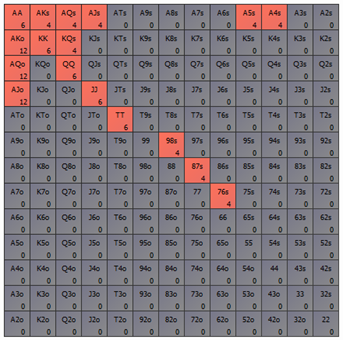
BTN 4-Bet Range Versus CO 3-Bet
Green = 4-bet (3.47% of all possible hands)
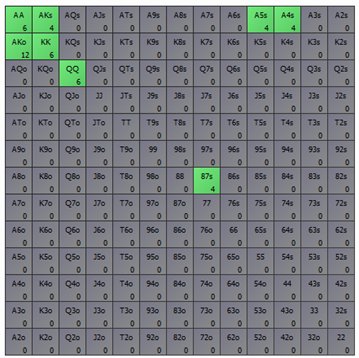
Facing a HJ open-raise and CO 3-bet, this 4-betting range from the BTN can be slightly wider than in the first example given the wider 3-betting range at play.
Example 3: SB Open-Raise Versus BB 3-Bet
BB 3-Bet Range Versus SB Open-Raise
Red = 3-bet (10.86% of all possible hands)
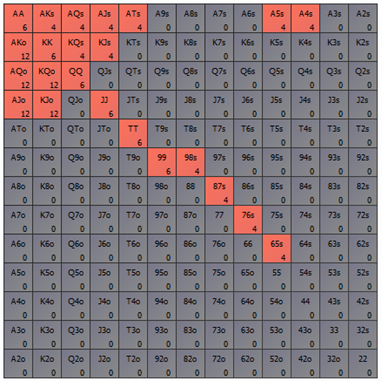
SB 4-Bet Range Versus BB 3-Bet
Green = 4-bet (4.83% of all possible hands)

In this example, you’ll notice that the SB 4-betting range is much wider than we’ve seen in the previous two examples. In this blind versus blind dynamic where the BB is expected to be 3-betting aggressively (10.89% of all hands), you can justifiably expand a 4-betting range to include more value combos (JJ and AQs), along with a few additional bluffs for balance (67s and 89s).
The Theory of Hand Selection
It is helpful to understand the logic behind these ranges so that you can make your own adjustments to them when necessary. When constructing a 4-betting range and deciding which hands to use as bluffs, you should consider the following:
Using Blockers
Most importantly when selecting bluff combos, it is beneficial to choose those which block your opponent from having strong hand. For example, you’ll see that A5s is used as a bluff in all of the above 4-betting ranges. This is because when we have an ace in our hand and elect to 4-bet with it, our opponent is 50% less likely to have AA (only 3 available combos instead of 6) and 25% less likely to have AK (12 combos available instead of 16).
Importance of Equity Realisation
When choosing our bluffs, we want to pick hands which realise their equity well. This means selecting hands that will connect with the board effectively over a range of textures, making draw opportunities and the capacity to have a very strong hand by showdown. This runs parallel to the idea of raw equity – the equity that a hand has across all streets, assuming that a player is all-in and will be reaching showdown. There are hands which have better raw equity than the bluffs outlined above, but this doesn’t make them better candidates for 4-betting. A9o for example has more raw equity than a hand like 78s, but realising your equity post-flop with a hand like A9o becomes very difficult. This is because you won’t readily flop many draws, and the weaker kicker to your ace will prevent you from value-betting over multiple streets when you pair up. For this reason, 4-bet bluffing with hands that are well-connected and suited makes a lot more sense – even if these hands have worse raw equity than others.
Covering the Board
It is also important to construct a 4-betting range that is able to connect with both low-card and high-card boards. This is why there are middling suited-connectors featured as bluffs in these ranges (67s, 78s, 89s). If we don’t have hands like these in our 4-betting range, our opponent can exploit this by playing aggressively on low board textures that do not connect well with our range given its high-card imbalance.
Using a Frequency-Based Strategy
High-level poker players will often make frequency-based decisions. This means that they will take different actions with the same hand at varying frequencies (expressed as a percentage). While this might seem strange, it actually makes a lot of sense. Imagine that we are playing against two opponents at the poker table – Person 1 and Person 2. Person 1 will always make the same decision when holding a certain hand in a certain spot. For example, if they have AA and face a 3-bet, they will always 4-bet. By contrast, Person 2 in this same situation will take different actions based upon frequencies – by 4-betting 60% of the time and calling 40% of the time, for example. This difference makes Person 1 much easier to play against than Person 2, because we are able to clearly define their range based upon their actions. From the example given, we now know that whenever Person 1 calls a 3-bet, they cannot have AA in their range. When their range is capped in this way, we can use this information to exploit them post-flop. However, with Person 2 that uses a mixed strategy based upon frequencies, we cannot confidently define their ranges by the actions that they have taken. This means that they will be a lot tougher to exploit.
Balancing Your Ranges Against Strong Players
In the 4-betting ranges outlined above, you’ll see that AA is marked as a 4-bet in all scenarios. However, against skilled opponents that will be looking for ways to exploit us, it makes sense to use a mixed strategy. By calling a 3-bet at some frequency with AA, we prevent our 3-bet calling range from lacking nutted hands.
Don’t Bloat Your 4-Betting Range
We can also use frequency-based decision making to prevent our 4-betting ranges from becoming too large. In the SB vs BB example above, there are 12 combos of suited-connectors used as 4-bet bluffs. However, our 4-betting range can become too wide if we raise with all of these combos 100% of the time. Instead, if we decide to 4-bet with these combos 50% of the time, call with them 25% of the time and fold the other 25%, we can prevent this from happening. This concept is particularly useful when 4-betting off-suit unpaired hands. Let’s take AQ - Given that there are 12 combos of AQo and only 4 combos of AQs, your 4-betting range can very quickly swell in size if you elect to raise with all 12 combos of AQo.
Exploitative Adjustments
We can adjust our 4-betting range to exploit any unbalances in our opponents’ strategies and counter them effectively. Against an extremely loose player that is 3-betting at a very high frequency from all positions, we can adjust to this by widening our 4-betting range appropriately. The stronger hands in our standard 3-bet calling range can now become 4-bets, punishing the player for raising too wide. Conversely, against a player that has an extremely tight 3-betting range (consisting only of QQ+ and AK), it only makes sense to have a very narrow 4-betting range.
Correct 4-Bet Sizing
In terms of optimal 4-bet sizing, we want to choose a size that accomplishes a few things. First, we need to use a size large enough to prevent our opponent(s) from getting a very good price on a call. Second, we need a size that is large enough to generate some fold equity, meaning that our opponent will be folding enough of their range that our bluffs get through at an adequate frequency. However, we shouldn’t 4-bet to a size that commits us to a 5-bet jam from our opponent, as we need to be able to fold our 4-bet bluffs to a 5-bet jam without committing too much of our stack. Assuming that we have open-raised to 3bb and face a 10.5bb 3-bet, we should aim to 4-bet to a size of around 22-24bb. A good general rule of thumb is to make the 4-bet around 2.2x the size of the 3-bet. For every additional caller of the open-raise, you should add an additional open-raise size to your 4-bet. For every 3-bet caller in the pot, you should add an additional 7-10bb to your 4-bet sizing.
Having outlined all of the key concepts we need to know to begin 4-betting effectively at the table, you should now have a good fundamental understanding of how to construct your own 4-betting ranges. Always remember that you should be fluid with your ranges: they should change based upon prior action in the hand, the sizes of the bets in play and the general tendencies of the players involved.

